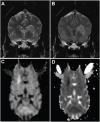Multiplex analysis of cytokines in the cerebrospinal fluid of dogs after ischemic stroke reveals elevations in chemokines CXCL1 and MCP-1
- PMID: 37266378
- PMCID: PMC10230061
- DOI: 10.3389/fvets.2023.1169617
Multiplex analysis of cytokines in the cerebrospinal fluid of dogs after ischemic stroke reveals elevations in chemokines CXCL1 and MCP-1
Abstract
Introduction: Neuroinflammation that occurs in the brain after stroke has been shown to be important to disease pathogenesis and outcomes. The aim of this study was to evaluate a large number of pro- and anti-inflammatory cytokines in dogs with clinically-confirmed, naturally occurring stroke.
Materials and methods: Fifteen dogs with a clinical diagnosis of ischemic stroke and ten healthy control dogs were included in the study. A multiplex immunoassay was utilized to evaluate cerebrospinal fluid for GM-CSF, IFN-γ, IL-2, IL-4, IL-6, IL-7, IL-8, IL-10, IL-15, IL-18, IP-10, CXCL1, MCP-1, and TNF-α.
Results: Mean concentrations of CXCL1 (stroke-436 pg/ml, control-267 pg/ml, p = 0.01) and MCP-1 (stroke-196 pg/ml, control-66 pg/ml, p ≤ 0.0001) were significantly elevated in dogs with stroke when compared with control dogs. Location and type of infarct, duration of clinical signs, and use of anti-inflammatory medications were not associated with differences in cytokine concentration.
Discussion: CXCL1 and MCP-1 may play a role in naturally occurring canine stroke and represent targets for future research.
Keywords: CXCL1; MCP-1; cerebrospinal fluid; cerebrovascular accident; chemokine; cytokine; dog; stroke.
Copyright © 2023 Barber, Platt, De Risio, Barber and Robinson.
Conflict of interest statement
LD is an employee of Linnaeus Veterinary Limited, a provider of veterinary services. The remaining authors declare that the research was conducted in the absence of any commercial or financial relationships that could be construed as a potential conflict of interest.
Figures


References
LinkOut - more resources
Full Text Sources
Miscellaneous

